scroll use "rules"
+8
Hans Vleugels
marcus watts
kora
dick benbow
Norma
Kakejiku
JimLewis
fiona
12 posters
Page 1 of 2
Page 1 of 2 • 1, 2 
 scroll use "rules"
scroll use "rules"
Version Two of this thread as it wasn't clear enough what question(s) I was asking last time:
What, if any, are the "rules" for using a scroll in a traditional bonsai display?
What, if any, are the "rules" for using a scroll in a traditional bonsai display?

fiona- Member
 Re: scroll use "rules"
Re: scroll use "rules"
And/Or to be even more specific, does a display have to have the "meaning" that those posters who clearly have a lot of knowledge on the subject mention?
It seems to me to be becoming increasingly more frequent that bonsai are displayed with scrolls (and especially with accent plants) with little or no regard to any cohesive "meaning" in the display. Does this matter any more or should we discard the notion of meaning and just accept that the principal criterion for selecting the scroll/accent plant was because it is now fashionable to display using scrolls/accent plants and/or because it "looked pretty" in the eye of the creator?
btw this is not a criticism of anyone's display - it is merely an observation of what seems to be happening. But I will put my head above the parapet and say that I personally would prefer if trees were displayed without scrolls rather than with a badly-chosen one.
It seems to me to be becoming increasingly more frequent that bonsai are displayed with scrolls (and especially with accent plants) with little or no regard to any cohesive "meaning" in the display. Does this matter any more or should we discard the notion of meaning and just accept that the principal criterion for selecting the scroll/accent plant was because it is now fashionable to display using scrolls/accent plants and/or because it "looked pretty" in the eye of the creator?
btw this is not a criticism of anyone's display - it is merely an observation of what seems to be happening. But I will put my head above the parapet and say that I personally would prefer if trees were displayed without scrolls rather than with a badly-chosen one.

fiona- Member
 Re: scroll use "rules"
Re: scroll use "rules"
Perhaps, because people may have missed the link embedded in Kakejiku's response in that other thread, we should include it here as a point of reference?
http://www.bonsai.ie/selecting-appropriate-scrolls-for-bonsai-display/
I hope this discussion keeps going.
http://www.bonsai.ie/selecting-appropriate-scrolls-for-bonsai-display/
I hope this discussion keeps going.

JimLewis- Member
 Re: scroll use "rules"
Re: scroll use "rules"
fiona wrote:And/Or to be even more specific, does a display have to have the "meaning" that those posters who clearly have a lot of knowledge on the subject mention?
It seems to me to be becoming increasingly more frequent that bonsai are displayed with scrolls (and especially with accent plants) with little or no regard to any cohesive "meaning" in the display. Does this matter any more or should we discard the notion of meaning and just accept that the principal criterion for selecting the scroll/accent plant was because it is now fashionable to display using scrolls/accent plants and/or because it "looked pretty" in the eye of the creator?
This is a good point and I want to ramble on about some things.
The first thing...is that Gadou focus is on "Asobi no Kokoro", or a playful heart. Meaning it should bring joy to the person displaying their bonsai or stone and to the individuals viewing it.
Getting caught up in the guidelines (I used guidelines on purpose) makes it no fun...
1. For starters, we would need to know the diverse guidelines,
2. And if you really wanted to follow the guidelines, you would need a whole arsenal of Tables, Jiita and kakejiku (wallscrolls), which for most bonsaiist's is impractical or unattainable.
3. The bonsai artist should remember that the tree should be the focus of the display and the painting should not overpower the display in any way.
Personally, I would like to see more regionalism in the display. Just as an example, one customer told me she wanted a waterfall that flowed from right to left...so without really understanding the customer's needs I told the artist to paint very minimal with a lot of white space and no vegetation with few rocks....this is what I thought a person would be looking for in the traditional sense....This is what the artist came up with. (Note: This is the waterfall scroll being discussed in Japanese in the thread titled "Kuzuhara Ikkou Display")

Then customer said no...no...this is not what I had envisioned....I want it to look like this river where I live.
 I
I So now I give this to the artist and he recreates the image very accurately. He still leaves out the trees on the side...but we now know from the previous thread that this is not what a traditional Japanese bonsai artist would like to display. But this is the end result for the customer.

I guess my post did not answer any question, but gives some ideas to ponder in their heart about.

Kakejiku- Member
 Re: scroll use "rules"
Re: scroll use "rules"
Hi fiona,
It's been my understanding from past discussions about proper display, that the scroll's signature or hanko seal is on the opposite side of the primary object (bonsai or stone).
The use of kanji on the scroll is many times a "foil" used to replace the seasonal scroll; for most people seldom know what the words mean. I,once used a kanji scroll with a large rabbit stone at an annual show. When the judge asked me what it said...I joked, "Peter Rabbit" , not thinking it would be taken seriously. So, now I just shrug!!
Norma
It's been my understanding from past discussions about proper display, that the scroll's signature or hanko seal is on the opposite side of the primary object (bonsai or stone).
The use of kanji on the scroll is many times a "foil" used to replace the seasonal scroll; for most people seldom know what the words mean. I,once used a kanji scroll with a large rabbit stone at an annual show. When the judge asked me what it said...I joked, "Peter Rabbit" , not thinking it would be taken seriously. So, now I just shrug!!
Norma

Norma- Member
 Re: scroll use "rules"
Re: scroll use "rules"
I'm always sending pictures of my alcove display to my teacher, david de groot. Without fail, I'll have 3 elements in it, bonsai, companion and scroll and in a diplomatic way, he always reminds me that having 3 of anything is quite the stretch and that the story could easily be told with one bonsai, or perhaps with one other element .
So is the story any different when a bonsai is not used but perhaps a suiseki as the lead element?
I keep getting reminded, that the concept is that less is more.
So is the story any different when a bonsai is not used but perhaps a suiseki as the lead element?
I keep getting reminded, that the concept is that less is more.
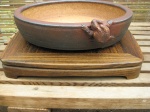
dick benbow- Member
 rules for scrolls
rules for scrolls
maybe we should rename this thread as recommendations and not rules, because there are many or few depending on who you listen to. F.i. Yes it is recommended that the hanko is on the opposite side of the main object, which could be a tree a kusamono or a suiseki, but if you only have one good waterfall, and the hanko is on the "wrong" side, its not a great no no-especially for us in the West, where we do not have access to every manner of scrolls. There are more rules if you are displaying in a Tokonoma, rather than a table top display, so we learned yesterday and today from
Mr. Morimae at the International Stone show here in Harrisburg. He stressed over and over again, that one element in the display needs to convey the seasonality. F.i. if you are showing a maple in color, that makes it clear that it is Fall. The scroll, and or companion plant and or scroll then don't need to convey the season. if however the main feature is a juniper, you must express the season with one other accessory.
Mr. Morimae also mentioned, that if you use calligraphy, that it be apropriate-i.e. masculine trees, need strong scrolls,and stands, and that they say the right thing. There is more to be said, but i am falling asleep and it has been a long intensive day of learning. more soon,kora
Mr. Morimae at the International Stone show here in Harrisburg. He stressed over and over again, that one element in the display needs to convey the seasonality. F.i. if you are showing a maple in color, that makes it clear that it is Fall. The scroll, and or companion plant and or scroll then don't need to convey the season. if however the main feature is a juniper, you must express the season with one other accessory.
Mr. Morimae also mentioned, that if you use calligraphy, that it be apropriate-i.e. masculine trees, need strong scrolls,and stands, and that they say the right thing. There is more to be said, but i am falling asleep and it has been a long intensive day of learning. more soon,kora
kora- Member
 Re: scroll use "rules"
Re: scroll use "rules"
purely from the asthetics I find a display area smaller than 5 or 6ft wide looks too cluttered up with a bonsai on a stand, an accent on a stand and a scroll. I've seen show trees visually ruined when the scroll is very close to, or worse still partly behind the foliage - As an observer you lose the clear defined tree silloette.
It also seems easy to confuse making a seasonal display in the home with making a display at a bonsai exhibition - A row of 20 scrolls along one section of exhibition tables would just be a visual mess - maybe this is why they are not included in the top Japanese shows or our European Noelanders show ?( I watched a film with Mark Noelanders saying he basically got fed up with poor quality, homemade and innapropriate scrolls at the show.) I even feel the companion plantings are getting equally cluttered and confused at times - detracting further from the actual Tree. A small multi species planting in an amazing pot with a bronze sculpture of some description can be a beautiful thing in its own right - but it screams 'look at me, look at me' so for me has no place as part of a proper bonsai show exhibit.
Personally I think the order of importance at a show is Tree, Pot, Stand, Accent & stand, Name/info plate, (Scroll). In a stand alone display rather than a proper show I would place equal importance on a suitable accent and scroll while not using an info card.
It also seems easy to confuse making a seasonal display in the home with making a display at a bonsai exhibition - A row of 20 scrolls along one section of exhibition tables would just be a visual mess - maybe this is why they are not included in the top Japanese shows or our European Noelanders show ?( I watched a film with Mark Noelanders saying he basically got fed up with poor quality, homemade and innapropriate scrolls at the show.) I even feel the companion plantings are getting equally cluttered and confused at times - detracting further from the actual Tree. A small multi species planting in an amazing pot with a bronze sculpture of some description can be a beautiful thing in its own right - but it screams 'look at me, look at me' so for me has no place as part of a proper bonsai show exhibit.
Personally I think the order of importance at a show is Tree, Pot, Stand, Accent & stand, Name/info plate, (Scroll). In a stand alone display rather than a proper show I would place equal importance on a suitable accent and scroll while not using an info card.

marcus watts- Member
 Re: scroll use "rules"
Re: scroll use "rules"
I don't normally like quoting entire posts, but Marcus has struck the nail on the head for me and his response more or less sums up my own concerns about scroll/accent etc use. It seems to me that in our haste to copy the perceived Japanese way, we have lost a lot of understanding of what that way actually was. Use of scrolls etc therefore has been simply because "that's what we're supposed to do" and as a result we have some very cluttered, unattractive and incohesive displays.marcus watts wrote:purely from the asthetics I find a display area smaller than 5 or 6ft wide looks too cluttered up with a bonsai on a stand, an accent on a stand and a scroll. I've seen show trees visually ruined when the scroll is very close to, or worse still partly behind the foliage - As an observer you lose the clear defined tree silloette.
It also seems easy to confuse making a seasonal display in the home with making a display at a bonsai exhibition - A row of 20 scrolls along one section of exhibition tables would just be a visual mess - maybe this is why they are not included in the top Japanese shows or our European Noelanders show ?( I watched a film with Mark Noelanders saying he basically got fed up with poor quality, homemade and innapropriate scrolls at the show.) I even feel the companion plantings are getting equally cluttered and confused at times - detracting further from the actual Tree. A small multi species planting in an amazing pot with a bronze sculpture of some description can be a beautiful thing in its own right - but it screams 'look at me, look at me' so for me has no place as part of a proper bonsai show exhibit.
Personally I think the order of importance at a show is Tree, Pot, Stand, Accent & stand, Name/info plate, (Scroll). In a stand alone display rather than a proper show I would place equal importance on a suitable accent and scroll while not using an info card.
Marcus makes an interesting distinction between use in a domestic tokonoma and in a show though. I am familiar with the idea of using the three elements arises from the tokonoma, but when did it get taken over into the exhibition arena? Or is the need for scroll/accent just another western "myth"?
I am now veering towards a simple display of tree and maybe an accent planting if it throws the focus on to the tree. My only real must have is a suitable stand for the tree as I really do think that enhances the tree enormously.
Last edited by fiona on Sun Oct 07, 2012 9:59 am; edited 1 time in total (Reason for editing : hit Send rather than Preview the first time.)

fiona- Member
 Re: scroll use "rules"
Re: scroll use "rules"
Kora, thank-you for sharing what you learned from your event attendance. I hope you'll continue to pass along those priceless nuggets for those of us not able to attend.
I really do think that this thread continues to be helpful as contributions continue to be expressed.
I really do think that this thread continues to be helpful as contributions continue to be expressed.

dick benbow- Member
 Re: scroll use "rules"
Re: scroll use "rules"
Hi Fiona,
Maybe this might be helpful... it was written by Paul Goff of www.bonsaipresentations.com, you could find this text on a paper inside his boxes when you bought a scroll from him...
Guidelines for the use of Hanging Scrolls
When displaying bonsai, suiseki or kusamono the employment of a hanging scroll may be the perfect way to enhance the mood or season. In any event, the scroll should be one of no more than three items in an arrangement i.e.
Bonsai with accent planting and scroll
Bonsai with scroll
Bonsai with suiseki and scroll
Suiseki with scroll
Kusamono with scroll
It’s important to decide if your display is describing the season or simply mood and atmosphere or time of day in the natural landscape. If you intend to use a scroll in a display with bonsai, it’s vitally important that the scroll is minimal in its content and composition to avoid conflict with other elements in the arrangement. The message in the scroll should be conveyed by subtle implication and should contribute to the whole story within the parameters of the display.
If the display is to imply a season, it is usual for one of the accessories (i.e. scroll, accent) to look forward to the oncoming time of year but without leaping into the next season, hence implying the continued progression of nature. For example, in a midwinter bonsai display, the use of a snowdrop as accent or subtle scroll illustration will imply looking ahead to warmer days without jumping right into spring. Similarly, a pine displayed in late summer may be accompanied by a scroll with a single falling deciduous leaf to suggest the beginning of autumn. It would not be appropriate to make too large a statement with total fall time here, but just enough to imply progression and not regression. Likewise, a display set in early spring may be enhanced by the use of a scroll containing reference to young chicks or fledglings, hence looking forward by just a few weeks.
It is essential to avoid repetition in your display arrangement, which includes the hanging scroll. For example, in the aforementioned scenario of a pine in late summer with a falling deciduous leaf, it would be inappropriate here if the bonsai was deciduous because of the repetition of leaves. In any event, the scroll should never include trees per se because of repetition. Also, if an early season display is centered around a flowering bonsai, then flowers should not be evident on the scroll or the accent. Rock planted bonsai should not have stones or mountain scenes included in the arrangement, but the season or mood could be enhanced by an illustration of insects, birds or the sun in the mist; in other words, natural elements which may be observed at that location.
The size and colour of the scroll is also an important factor. Remember that no elements in a display should dominate and cause undue attention. Highly elaborate colours and fabrics are best avoided. As a rough guide, it’s usual that the wider the bonsai i.e.landscape planting, the wider the scroll and usually shorter, too, so that overall harmony and balance is retained. It’s important that any direction or movement that is apparent in the scroll illustration is in harmony with the perceived movement of the whole display. The objective is to retain the viewer’s attention within the display space or tokonoma.
To achieve good balance in the display, due consideration should be given to setting the height of the scroll. Wherever possible, the visual centre of the illustration in the scroll should be set higher than that of the bonsai or key element. If three elements are present, it should be possible to describe a scalene triangle between the visual centres of the objects where the scroll may be considered to represent the universe and heaven at the highest point of the triangle. Bonsai represents man at the mid-point whilst the lower point of this triangle is defined by an accent planting or figurine representing the earth. Many bonsai growers and enthusiasts will be familiar with this concept when applied to the creation of individual trees by using the triangle theme in the design.
Our hanging scrolls and illustrations are designed with emphasis on mood, atmosphere and seasonal change to cater for the exhibition and display needs of bonsai artists and enthusiasts. Please contact us if you require further assistance when selecting our products or if you require a specific illustration to suit your display. Please remember that our scrolls are of bonded oriental papers and fabrics and may require reverse rolling after storage in boxes or tubes to remove any temporary distortion in the scroll.
Hope this helps...
Best regards,
Hans
Maybe this might be helpful... it was written by Paul Goff of www.bonsaipresentations.com, you could find this text on a paper inside his boxes when you bought a scroll from him...
Guidelines for the use of Hanging Scrolls
When displaying bonsai, suiseki or kusamono the employment of a hanging scroll may be the perfect way to enhance the mood or season. In any event, the scroll should be one of no more than three items in an arrangement i.e.
Bonsai with accent planting and scroll
Bonsai with scroll
Bonsai with suiseki and scroll
Suiseki with scroll
Kusamono with scroll
It’s important to decide if your display is describing the season or simply mood and atmosphere or time of day in the natural landscape. If you intend to use a scroll in a display with bonsai, it’s vitally important that the scroll is minimal in its content and composition to avoid conflict with other elements in the arrangement. The message in the scroll should be conveyed by subtle implication and should contribute to the whole story within the parameters of the display.
If the display is to imply a season, it is usual for one of the accessories (i.e. scroll, accent) to look forward to the oncoming time of year but without leaping into the next season, hence implying the continued progression of nature. For example, in a midwinter bonsai display, the use of a snowdrop as accent or subtle scroll illustration will imply looking ahead to warmer days without jumping right into spring. Similarly, a pine displayed in late summer may be accompanied by a scroll with a single falling deciduous leaf to suggest the beginning of autumn. It would not be appropriate to make too large a statement with total fall time here, but just enough to imply progression and not regression. Likewise, a display set in early spring may be enhanced by the use of a scroll containing reference to young chicks or fledglings, hence looking forward by just a few weeks.
It is essential to avoid repetition in your display arrangement, which includes the hanging scroll. For example, in the aforementioned scenario of a pine in late summer with a falling deciduous leaf, it would be inappropriate here if the bonsai was deciduous because of the repetition of leaves. In any event, the scroll should never include trees per se because of repetition. Also, if an early season display is centered around a flowering bonsai, then flowers should not be evident on the scroll or the accent. Rock planted bonsai should not have stones or mountain scenes included in the arrangement, but the season or mood could be enhanced by an illustration of insects, birds or the sun in the mist; in other words, natural elements which may be observed at that location.
The size and colour of the scroll is also an important factor. Remember that no elements in a display should dominate and cause undue attention. Highly elaborate colours and fabrics are best avoided. As a rough guide, it’s usual that the wider the bonsai i.e.landscape planting, the wider the scroll and usually shorter, too, so that overall harmony and balance is retained. It’s important that any direction or movement that is apparent in the scroll illustration is in harmony with the perceived movement of the whole display. The objective is to retain the viewer’s attention within the display space or tokonoma.
To achieve good balance in the display, due consideration should be given to setting the height of the scroll. Wherever possible, the visual centre of the illustration in the scroll should be set higher than that of the bonsai or key element. If three elements are present, it should be possible to describe a scalene triangle between the visual centres of the objects where the scroll may be considered to represent the universe and heaven at the highest point of the triangle. Bonsai represents man at the mid-point whilst the lower point of this triangle is defined by an accent planting or figurine representing the earth. Many bonsai growers and enthusiasts will be familiar with this concept when applied to the creation of individual trees by using the triangle theme in the design.
Our hanging scrolls and illustrations are designed with emphasis on mood, atmosphere and seasonal change to cater for the exhibition and display needs of bonsai artists and enthusiasts. Please contact us if you require further assistance when selecting our products or if you require a specific illustration to suit your display. Please remember that our scrolls are of bonded oriental papers and fabrics and may require reverse rolling after storage in boxes or tubes to remove any temporary distortion in the scroll.
Hope this helps...
Best regards,
Hans

Hans Vleugels- Member
 Re: scroll use "rules"
Re: scroll use "rules"
Thanks Hans. When I was first getting into scrolls I spent a wonderful day with Paul at his house listening, doing and learning.
But here's the question: Is Paul talking about tokonoma displays or displays at exhibitions? Or indeed both?
When I was at his house, we put together displays in his tokonoma and I came away with a decent grasp of the basics (very much "entry level" knowledge) of the three element display. But are we just assuming that this tokonoma technique can transfer straight to how we display at shows? Marcus has already cited the Noelanders approach which removes scrolls from the equation - a decision which seems to be partly on space considerations but even more on aesthetic ones.
I love scrolls and own many - both Paul's and some older Chinese ones - and I am always highly interested in posts from Kakejiku and others who have far more knowledge of them. But I am still concerned that the whole scrolls in display thing is just something we have latched upon in the west as an "oh you must have a scroll in an exhibition display" with no real justification for it.
Examples for comments:
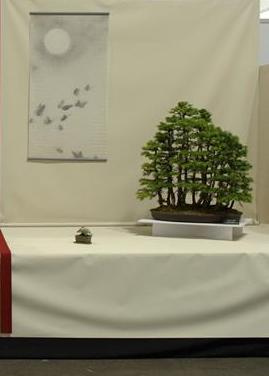
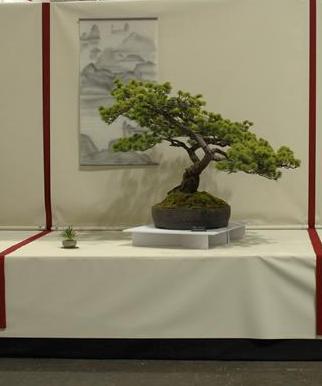
But here's the question: Is Paul talking about tokonoma displays or displays at exhibitions? Or indeed both?
When I was at his house, we put together displays in his tokonoma and I came away with a decent grasp of the basics (very much "entry level" knowledge) of the three element display. But are we just assuming that this tokonoma technique can transfer straight to how we display at shows? Marcus has already cited the Noelanders approach which removes scrolls from the equation - a decision which seems to be partly on space considerations but even more on aesthetic ones.
I love scrolls and own many - both Paul's and some older Chinese ones - and I am always highly interested in posts from Kakejiku and others who have far more knowledge of them. But I am still concerned that the whole scrolls in display thing is just something we have latched upon in the west as an "oh you must have a scroll in an exhibition display" with no real justification for it.
Examples for comments:



fiona- Member
 Re: scroll use "rules"
Re: scroll use "rules"
I'll keep my eyes open for the use of scrolls in displays at the Carolina Bonsai Expo next weekend. They're used, but rarely, there -- and I recall thinking the the ones I did see were from the tourist trade and a bit on the tacky side. Here is what I consider to be a fairly well-done exception:
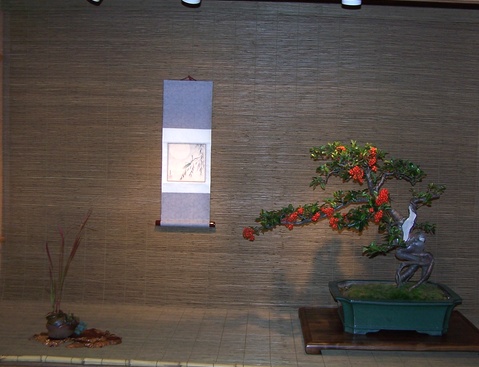
I only have one kakemono, and at six feet tall, it a bit large to be displayed with any of my trees. My parents picked it up when we lived there in the 1950s. It was an antique then, so if there are degrees of antiqueness, it is even more of one now. All that said, I've never liked it.

I often display trees in my home, though we don't have a tokonome. However, our walls are covered with part of our Ukiyoe collection, so there is a tie to Japan (FWIW). I've shown pics of a few of those displays here.
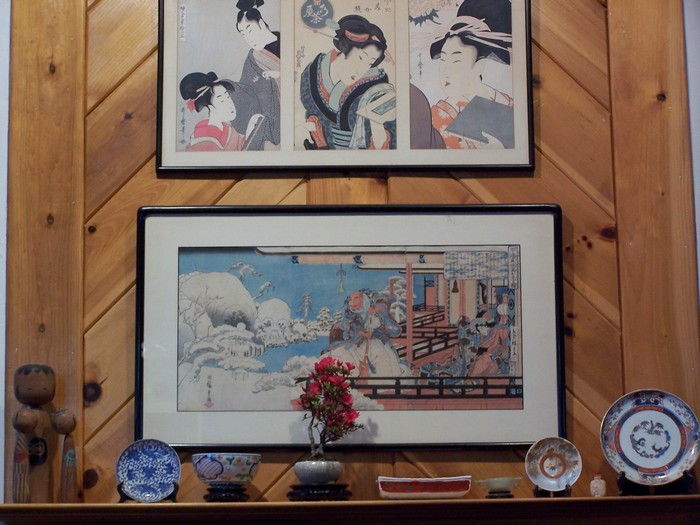
I do wonder, though, like Fiona, if we aren't sometimes obsessed with the Japan-ness of our trees and feel a certain obligation to display our trees just like they do.
On the other hand, there is a sameness (and a dullness) in the cloth-covered-table-and-plain-drapery-background tables seen at most shows.
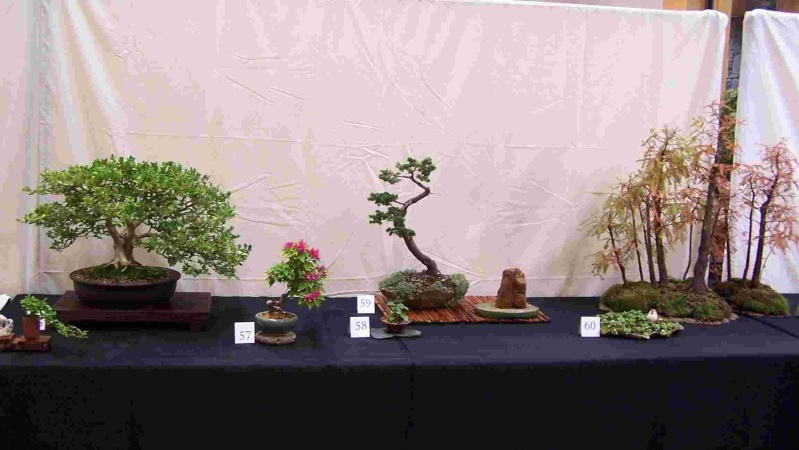
Occasionally, though, clubs at the Expo come up with ideas that bring their displays out of the ordinary. Some work, others don't.
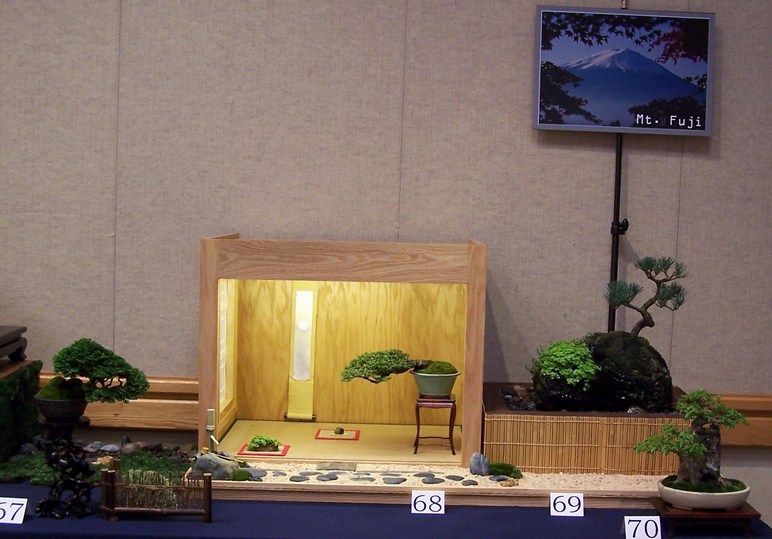
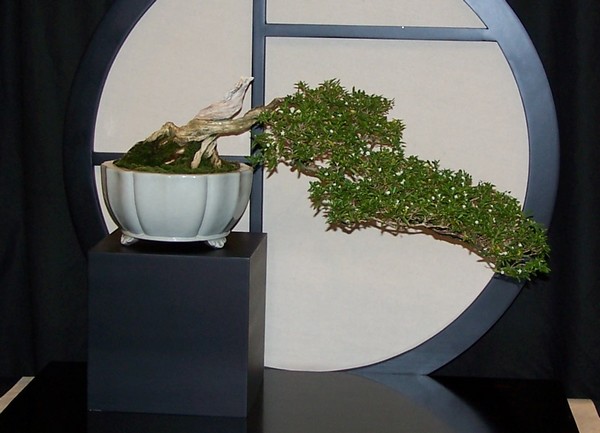

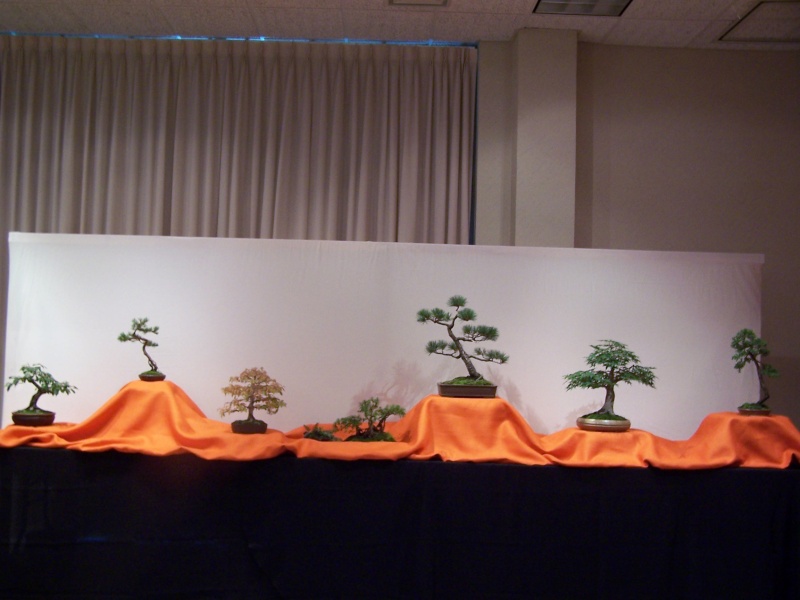


I only have one kakemono, and at six feet tall, it a bit large to be displayed with any of my trees. My parents picked it up when we lived there in the 1950s. It was an antique then, so if there are degrees of antiqueness, it is even more of one now. All that said, I've never liked it.

I often display trees in my home, though we don't have a tokonome. However, our walls are covered with part of our Ukiyoe collection, so there is a tie to Japan (FWIW). I've shown pics of a few of those displays here.

I do wonder, though, like Fiona, if we aren't sometimes obsessed with the Japan-ness of our trees and feel a certain obligation to display our trees just like they do.
On the other hand, there is a sameness (and a dullness) in the cloth-covered-table-and-plain-drapery-background tables seen at most shows.

Occasionally, though, clubs at the Expo come up with ideas that bring their displays out of the ordinary. Some work, others don't.






JimLewis- Member
 Re: scroll use "rules"
Re: scroll use "rules"
For me the first one is way too big for the group planting. The scale of the scene is ruined my such large details on the scroll.
Number two is just taking up a space behind the tree that would be better left plain. Both are just grey smudgy bits of paper too, no borders or definition between the picture and the backgrounds. Both get thumbs down from me.
Nice collection of examples Jim - as you say some are better than others
I'm looking forward to seeing the artisans cup - I think the trees will possibly get the launchpad they deserve.........I persoannly feel that just Tree Pot Stand could be so much better in many bonsai shows, especially if less than 5ft is available to all exhibits

marcus watts- Member
 Re: scroll use "rules"
Re: scroll use "rules"
marcus, don't you feel that in shows, the purpose is quite different than in tokonoma or alcove display.
We are indeed very fortunate to have ryan and michael preparing to have a top notch display in the pacific NW.
We are indeed very fortunate to have ryan and michael preparing to have a top notch display in the pacific NW.

dick benbow- Member
 Re: scroll use "rules"
Re: scroll use "rules"
dick benbow wrote:marcus, don't you feel that in shows, the purpose is quite different than in tokonoma or alcove display.
.
Hi Dick,
Yes I do completely - the two diciplines should be completetly different though and not become mingled together. To take a bonsai tree at a seasonally perfect moment and form a display to complement it has absolutely nothing to do with a bonsai exhibition, or competition. I see this as a celebration of the season, time of year or a particular moment in a trees' life - ie flowering, colour etc This is why I think a good accent and scroll can complement such a display. I suspect that a smaller percentage of bonsai growers do this though
The show scenario has a fixed date, a fixed duration and is primarily to exhibit bonsai trees where they will be either just enjoyed, or judged for awards. Seasonality now has very little to do with the vast majority of the exhibits - it will be a collection of the (hopefully) best trees available in a given catchment area. This is where I'm begining to think why do we need anything more than tree,pot,stand ? How really does even an accent plant help the show entry, other than hopefully giving the entrant more space to put their tree in. I see an equal 'crime' where accents are squeezed in front of bonsai trees - it shows a mentality of "I own it, I carried it here, I'm using it regardless".
My observation are that at shows the accents get very little attention anyway, and mostly by gardeners. A simple test, look at all the show picture threads on here - trees dominate as that is our primary interest.
cheers Marcus

marcus watts- Member
 Re: scroll use "rules"
Re: scroll use "rules"
I don't particularly agree with that - case in point being the enormous popularity of a recent show dedicated to accent plants.marcus watts wrote: My observation are that at shows the accents get very little attention anyway, and mostly by gardeners.
And now it is perhaps time to upset the apple cart slightly. The following is just MHO, but if we look at quite a few of the show threads on here we will find that at the bulk of them there is some attempt to display the tree using at least an accent plant and sometimes and/or a scroll or background picture. Yet (and again this is MHO) in many cases the tree is lost in the clutter and the "complement" does anything but complement the tree. In my opinion, this has come about precisely because of some notion that this is either how we must display trees or in an attempt to be "arty".marcus watts wrote:A simple test, look at all the show picture threads on here - trees dominate as that is our primary interest.
There are of course many exhibitors who have got the attempt right and the exhibits (and indeed the overall exhibition) has benefited from it. But I'm afraid I'd rather see a tree displayed on an appropriate table only rather than poorly shown in a clutter of accoutrements just because someone thinks that's what should happen or because the creator thinks it's arty.
Or am I just being a purist snob here?

fiona- Member
 Re: scroll use "rules"
Re: scroll use "rules"
Thanks to everyone who contributes to this "conversation" which is so instructive for beginners like me.
I do love this quote! Tree has the leading role, tree is honoree! Absolute respect to the tree itself! Owner in return has the quiet, rewarding feeling of having worthy justified the tree at its celebration.marcus watts wrote: ... ...I see this as a celebration of the season, time of year or a particular moment in a trees' life - ie flowering, colour etc This is why I think a good accent and scroll can complement such a display... ...

my nellie- Member
 Re: scroll use "rules"
Re: scroll use "rules"
Perhaps it all comes down to the intent of the exhibitor... To tell a story or to show a tree? (obviously to tell a story requires the appropriate amount of space, the "right" accessories, and may not be a suitable choice for all shows)
Perhaps as a viewer that is question we should consider closely as we take in a show??
Over the last 20 years of participating in shows my purpose has freely moved between each of these positions. My experience tells me that most of the people that attend the shows I participate in rarely appreciate the story and are far more interested in the trees.
So...with that said...here is video of a display focused purely on the trees...no pots, no stands, no scrolls...maybe focused to a fault for many but it was fun:)
You may have noticed a picture in Jim's previous post of another display(the shohin wall) that was solely about the trees.
And here is a display that attempted to tell a story...

Once again the success of this effort was really in the mind of each viewer...
If we are really honest, it is not surprising that most fail in the "telling the story" efforts just as most fail at developing quality show trees...not saying we shouldn't have shows but 90% or more of the trees in most shows are average at best...just as 90% of the efforts to combine elements to tell a story are lost on the audience. So, as a viewer, I guess I just try to find the trees and displays that speak to me and do my best to appreciate those efforts...
John
Perhaps as a viewer that is question we should consider closely as we take in a show??
Over the last 20 years of participating in shows my purpose has freely moved between each of these positions. My experience tells me that most of the people that attend the shows I participate in rarely appreciate the story and are far more interested in the trees.
So...with that said...here is video of a display focused purely on the trees...no pots, no stands, no scrolls...maybe focused to a fault for many but it was fun:)
You may have noticed a picture in Jim's previous post of another display(the shohin wall) that was solely about the trees.
And here is a display that attempted to tell a story...
Once again the success of this effort was really in the mind of each viewer...
If we are really honest, it is not surprising that most fail in the "telling the story" efforts just as most fail at developing quality show trees...not saying we shouldn't have shows but 90% or more of the trees in most shows are average at best...just as 90% of the efforts to combine elements to tell a story are lost on the audience. So, as a viewer, I guess I just try to find the trees and displays that speak to me and do my best to appreciate those efforts...
John
jgeanangel- Member
 Re: scroll use "rules"
Re: scroll use "rules"
Oh so many points to answer. I'll start with the compliment: when I look at your displays, John, the key thing that strikes me is precisely that there has been a considerable degree of thought gone into them. I may not always like the end result but I won't argue that they are constructed around a definite story or design and are well-executed on that basis. The purists may throw their hands up in horror (as I imagine they did with the potless trees  ) but I would rather encounter something with a definite "idea" which is well-executed than something that has been thrown together with little in mind other than some idea that "this is how they do it in Japan." Ian Young has a thread on just now regarding a shohin show in Japan. Accent plants are used to enhance the tree but only where they actually do this. But not a scroll in sight.
) but I would rather encounter something with a definite "idea" which is well-executed than something that has been thrown together with little in mind other than some idea that "this is how they do it in Japan." Ian Young has a thread on just now regarding a shohin show in Japan. Accent plants are used to enhance the tree but only where they actually do this. But not a scroll in sight.
I find some of the other displays in the pictures put up by Jim to be too cluttered for my taste, and I've seen displays at other shows (and on this forum) that are, to me, just plain tacky. I and a handful of others have been trying to move bonsai display in Scotland away from being a large number of trees plonked down en masse on a table top. I think we are winning that battle but I'd hate to think all we are doing is substituting something equally poor.
I find some of the other displays in the pictures put up by Jim to be too cluttered for my taste, and I've seen displays at other shows (and on this forum) that are, to me, just plain tacky. I and a handful of others have been trying to move bonsai display in Scotland away from being a large number of trees plonked down en masse on a table top. I think we are winning that battle but I'd hate to think all we are doing is substituting something equally poor.

fiona- Member
 Scroll Crazy
Scroll Crazy
Whilst having a scroll may enhance ones enjoyment when viewing a bonsai in an exhibition they must never simply be included because it is 'the thing to do'. If you go back a few years the UK went 'scroll crazy', (I think I have only ever shown a tree twice with a scroll) with almost every tree chaperoned by a scroll...this is something that thankfully passed me by.
At many shows, including the prestigious Noelanders Show in January Scrolls are discouraged, tables are insisted upon and accents essential. I believe that scrolls do NOT accompany any trees at Kokofu Ten (citation needed*)
Beginners should concentrate on the quality of their trees and NOT get encumbered with yet something else to think about.
*I have yet to attend the Kokufu Exhibition
At many shows, including the prestigious Noelanders Show in January Scrolls are discouraged, tables are insisted upon and accents essential. I believe that scrolls do NOT accompany any trees at Kokofu Ten (citation needed*)
Beginners should concentrate on the quality of their trees and NOT get encumbered with yet something else to think about.
*I have yet to attend the Kokufu Exhibition
Guest- Guest
 Re: scroll use "rules"
Re: scroll use "rules"
Beginners should concentrate on the quality of their trees and NOT get encumbered with yet something else to think about.
Yup! Whether that is scrolls, stones, or accents.

JimLewis- Member
 Re: scroll use "rules"
Re: scroll use "rules"
re: Kokufu-ten: There are NEVER any scrolls , but ALWAYS companion plants. You don't see the companion plants in the books,except in the 3 point displays- mid-size bonsai, because they would get lost in the photograph of the large trees. If it wasn't so impossible for me to upload-have not got the hang of it-I'd be showing you a picture I took long time ago from above the show, which clearly shows companion plants next to each and every tree.
If you choose to exhibit in the traditional Japanese manner, then a companion plant or scroll or figurine is mandated.the companion plant serves a very important visual purpose, namely it separates the tree from the next one and serves to space the display-CAROLINAS display is clearly cluttered, looks more like a forest on stilts. It is however ok IMHO that we can decide how we want to show our trees, and if the person in charge or the exhibitor chooses to deviate from the Japanese norm, that should be ok.
Again, better no companion plant, than one that has been plopped into the wrong pot the day of the exhibit etc.
To Marcus: In a tokonoma type display-it is essential, that one element describe the season-if you are showing a conifer-that can be either a scroll, a figurine or a companion plant.
If you choose to exhibit in the traditional Japanese manner, then a companion plant or scroll or figurine is mandated.the companion plant serves a very important visual purpose, namely it separates the tree from the next one and serves to space the display-CAROLINAS display is clearly cluttered, looks more like a forest on stilts. It is however ok IMHO that we can decide how we want to show our trees, and if the person in charge or the exhibitor chooses to deviate from the Japanese norm, that should be ok.
Again, better no companion plant, than one that has been plopped into the wrong pot the day of the exhibit etc.
To Marcus: In a tokonoma type display-it is essential, that one element describe the season-if you are showing a conifer-that can be either a scroll, a figurine or a companion plant.
kora- Member
 Re: scroll use "rules"
Re: scroll use "rules"
tony wrote:... ...Beginners should concentrate on the quality of their trees and NOT get encumbered with yet something else to think about
JimLewis wrote:... ...Yup! Whether that is scrolls, stones, or accents.
Ultimately, I do appreciate your words of caution.... I need keeping back to the ground my enthusiasm every now and then

my nellie- Member
Page 1 of 2 • 1, 2 
 Similar topics
Similar topics» 2 Short rules question
» New size rules?
» Spring - Summer displays
» Buying Bonsai Pots
» Scroll for Each Season
» New size rules?
» Spring - Summer displays
» Buying Bonsai Pots
» Scroll for Each Season
Page 1 of 2
Permissions in this forum:
You cannot reply to topics in this forum






